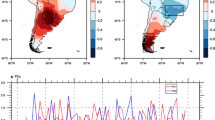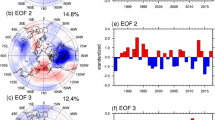Abstract
The amplitude phase characteristics (APC) or surface air temperature (SAT) annual cycle (AC) in the Northern Hemisphere are analyzed. From meteorological observations for the 20th century and meteorological reanalyses for its second half, it is found that over land negative correlation of SAT AC amplitude with annual mean SAT dominates. Nevertheless, some exceptions exist. The positive correlation between these two variables is found over the two desert regions: in northern Africa and in Central America. Areas of positive correlations are also found for the northern Pacific and for the tropical Indian and Pacific Oceans. Southward of the characteristic annual mean snow ice boundary (SIB) position, the shape of the SAT AC becomes more sinusoidal under climate warming. In contrast, northward of it, this shape becomes less sinusoidal. The latter is also found for the above-mentioned two desert regions. In the Far East (southward of about 50°N), the SAT AC shifts as a whole: here its spring and autumn phases occur earlier if the annual mean SAT increases. From energy balance climate considerations, those trends for SAT AC APC in the middle and high latitudes are associated with the influence of the albedo SAT feedback due to the SIB movement. In the Far East the trends are attributed to the interannual cloudiness variability, and in the desert regions, to the influence of a further desertification and/or scattering aerosol loading into the atmosphere. In the north Pacific, the exhibited trends could only be explained as a result of the influence of the greenhouse-gases loading on atmospheric opacity. The trends for SAT AC APC related to the SIB movement are simulated reasonably well by the climate model of intermediate complexity (IAP RAS CM) in the experiment with greenhouse gases atmospheric loading. In contrast, the tendencies resulting from the cloudiness variability are not reproduced by this model. The model also partly simulates the tendencies related to the desertification processes.
Similar content being viewed by others
References
Anisimov, O. A., and F. E. Nelson, 1996: Permafrost distribution in the Northern Hemisphere under scenarios of climatic change. Global Planet. Change, 14, 59–72.
Budyko, M. I., 1969: The effect of solar radiation variations on the climate of the earth. Tellus, 21, 611–619.
Budyko, M. I., I. M. Baikova, N. A. Efimova, and L. A. Strokina, 1998: A relationship between surface albedo and climate change. Rus. Meteor. Hydrol., (6), 21-5.
Budyko, M. I., and Yu. A. Izrael, editors, 1987: Anthropogenic Climate Changes. Gidrometeoizdat, Leningrad, 406 pp. (in Russian)
Claussen, M., and coauthors, 2002: Earth system models of intermediate complexity: closing the gap in the spectrum of climate system models. Climate Dyn., 18(7), 579 586.
Crutcher, H. L., and J. M. Meserve, 1970: Selected-level heights, temperatures and dew point temperatures for the Northern Hemisphere. Technical Report NAVAIR Rep. 50 1C-52, Naval Weather Service, Washington., D. C.
Demchenko, P. F., A. A. Velichko, A. V. Eliseev, I. I. Mokhov, and V. P. Nechaev, 2002: Dependence of permafrost conditions on global warming: Comparison of models, scenarios, and paleoclimatic reconstructions. Izv. Atmos. Oceanic Phys., 38(2), 143–151.
Diaz, H. F., and G. N. Kiladis, 1992: Atmospheric teleconnections associated with the extreme phase of the Southern Oscillation. El Niño: Historical and Paleoclimatic Aspects of the Southern Oscillation, H. F. Diaz and V. Markgraf Eds., Cambridge University Press, Cambridge, 7–28.
Dickinson, R. E., A. Henderson-Sellers, P. J. Kennedy, and M. F. Wilson, 1986: Biosphere-atmosphere transfer scheme (BATS). Technical Report NCAR/TN-275-STR, Naval Weather Service, Boulder, Colorado.
Eischeid, J. K., H. F. Diaz, R. S. Bradley, and P. D. Jones, 1991: A comprehensive precipitation data set for global land areas. Technical Report DOE/ER-69017T-H1, Carbon Dioxide Research Division, U.S. Department of Energy, Washington, D.C.
Eliseev, A. V., I. I. Mokhov, and N.Yu Vakalyuk, 2000: Tendencies of changes in the phase characteristics of the annual cycle of surface air temperature for the Northern Hemisphere. Izv., Atmos. Oceanic Phys., 36(1), 11–20.
Gavrilova, M. K., 1981: Present Day Climate and Permafrost over Continents. Nauka Publ. House, Novosibirsk, 112 pp. (in Russian)
Gibson, R., P. Kallberg, S. Uppala, A. Hernandez, A. Nomura, and E. Serrano, 1997: ERA description, ECMWF re-analysis project report series, Vol. 1. Technical report, European Centre for Medium-Range Weather Forecasts, Reading.
Gruza, G. V., E. Ya. Ran’kova, and Rocheva E. V., 1989: Analysis of global data on variations of surface air temperature during instrument observation period. Soviet Meteor. Hydrol., (1). 16–24.
Handorf, D., V. K. Petoukhov, K. Dethloff, A. V. Eliseev, A. Weisheimer, and I. I. Mokhov, 1999: Decadal climate variability in a coupled atmosphere-ocean climate model of moderate complexity. J. Geophys. Res., 104(D22), 27253–27275.
Hanson, H. P., 1991: Marine stratocumulus climatologies. Int. J. Climatol., 11, 147–164.
Houghton, J. T., B. A. Callander, and S. K. Varney, editors, 1992: Climate Change: The Supplementary Report to the IPCC Scientific Assessment, Intergovernmental Panel on Climate Change. Cambridge University Press, Cambridge, 198 pp.
Houghton, J. T., Y. Ding, D. J. Griggs, M. Noguer, P. J. van der Linden, X. Dai, K. Maskell, and C. A. Johnson, editors, 2001: Climate. Change 2001: The Scientific Basis. Contribution of Working Group I to the. Third Assessment Report of the Intergovernmental Panel on Climate Change. Cambridge University Press, Cambridge/New York, 881 pp.
Houghton, J. T., L. G. Meira Filho, B. A. Callander, N. Harris, A. Kattenberg, and K. Maskell, editors, 1996: Climate Change: The Science of Climate Change, Intergovernmental Panel on Climate Change. Cambridge University Press, Cambridge, 572 pp.
Jones, P. D., T. M. L. Wigley, and K. R. Briffa, 1994: Global and hemispheric temperature anomalies — land and marine instrumental records. Trends’93: A Compendium of Data on Global Change, Kaiser, R.J. Sepanski, and F.W. Stoss, Eds., number ORNL/CDIAC-65, Carbon Dioxide Information Analysis Center, Oak Ridge National Laboratory, Oak Ridge, Tenn., 603–608.
Kaiser, D. P., 1998: Analysis of total cloud amount over China. Geophys. Res. Lett, 25(19), 3599–3602.
Kalnay, E., and Coauthors, 1996: The NCEP/NCAR 40-year reanalysis project. Bull. Amer. Meteor. Soc, 77, 437–471.
Karl. T. R., G. Kukla, and J. Gavin, 1984: Decreasing diurnal temperature range in the United States and Canada from 1941 through 1980. J. Climate Appl. Meteor., 23(11), 1489–1504.
Manley, G., 1974: Central England temperature: Monthly means 1659 to 1973. Quart. J. Roy. Meteor. Soc, 100, 389–405.
Meehl, G. A., 1987: The annual cycle and interannual variability in the tropical Pacific and Indian Ocean regions. Mon. Wea. Rev., 115(1), 27–50.
Mokhov, I. I., 1981: Effect of CO2 on the thermal regime of the Earth’s climatic system. Soviet Meteor. Hydrol., (1), 17–26.
Mokhov, I. I., 1985: Method of amplitude-phase characteristics for analyzing climate dynamics. Soviet Meteor. Hydrol., (5), 14–23.
Mokhov, I. I., 1993: Diagnostics of Climate System Structure. Gidrometeoizdat, St. Petersburg, 271 pp. (in Russian)
Mokhov, I. I., P. F. Demchenko, A. V. Eliseev, V. Ch. Khon, and D. V. Khvorostyanov, 2002: Estimation of global and regional changes in XIX XXI centuries based on the IAP RAS climate model taking into account anthropogenic influence. Izv. Atmos. Ocean. Phys., 38(5), 555 568.
Mokhov. I. I., and A. V. Eliseev, 1997: Tropospheric and stratospheric temperature annual cycle: Tendencies of change. Izv. Atmos. Oceanic Phys., 33(4), 415–426.
Mokhov, I. I., and V. K. Petukhov, 1978: Parameterization of outgoing longwave radiation for climate models. Technical report, Institute of Atmospheric Physics, USSR Academy of Sciences, Moscow. (in Russian)
Monin, A. S., and Yu. A. Shishkov, 1979: The History of Climate. Gidrometeoizdat, Leningrad, 408 pp. (in Russian)
Nechaev, V. P., 1981: On some relations between parameters of permafrost and their paleogeographic application. Problems of Pleistocene Paleogeography in Glacial and Periglacial Regions, A. A. Velichko and V. P. Grichuk, Eds., Publ. House “Nauka”, Moscow, 211–220. (in Russian)
Norris, J. R., and C. B. Leovy, 1994: Interannual variability in stratiform cloudiness and sea surface temperature. J. Climate, 7(12), 1915–1925.
North, G. R., and J. A. Coakley, 1979: Differences between seasonal and mean annual energy balance model calculations of climate and climate sensitivity. J. Atmos. Sci., 36(7), 1189–1204.
Petoukhov, V. K., I. I. Mokhov, A. V. Eliseev, and V. A. Scmenov, 1998: The IAP RAS Global Climate Model. Dialogue-MSU, Moscow.
Philander, S. G., and E. M. Rasmusson, 1985: The Southern Oscillation and El Niño. Adv. Geophys., 28A, 197–215.
Polonsky, A. B., D. V. Basharin, and E. N. Voskresenskaya 2000: On oceanic influence on temperature variability of European and Mediterranean regions. Morskoi Gidrofiz. Zhur., (5), 32–46. (in Russian)
Quinlan, F. T., T. R. Karl, and C. N. Williams, 1987: United States Historical Climatology Network (HCN) serial temperature and precipitation data. Technical Report NDP-019, Carbon Dioxide Information Analysis Center, Oak Ridge National Laboratory. Oak Ridge.
Razuvaev, V. N., E. G. Apasova, and R. A. Martuganov, 1992: Daily and extreme temperature data sets within the USSR. Int. Temperature Workshop, D. Parder, Ed., Bracknell, Hadley Centre, United Kingdom Meteorological Office.
Rossow, W. B., and R. A. Schiffer, 1999: Advances in understanding clouds from ISCCP. Bull. Amer. Meteor. Soc, 80(11), 2261–2287.
Schlesinger, M. E., and J. F. B. Mitchell, 1986: Model projections of the equilibrium climatic response to increased carbon dioxide. Projecting the Climatic Effects of Increasing Carbon Dioxide, M.C. MacCracken and F.M. Luther, Eds., United States Department of Energy, Washington, D.C., 81–147.
Thompson, D. J., 1995: The seasons, global temperature, and precession. Science, 268, 59–68.
Valdes, P., 2000: Paleoclimate modeling. Numerical Modeling of the Global Atmosphere in the Climate System, P. Mote and A. O’Neill, Eds., Kluwer Acad-Publ., Dordrecht/Boston/London, 465 488.
Vclichko, A. A., editor, 1999: Climate and Environment Changes during the Last 65 Million Years(Cenozoic: from Paleocene to Holocenc). GEOS, Moscow, 260 pp. (in Russian)
Wcare, E. C, 1994: Interrelationships between cloud properties and sea surface temperatures on seasonal and interannual time scales, J. Climate, 7(2), 248–260.
Author information
Authors and Affiliations
Corresponding author
Rights and permissions
About this article
Cite this article
Eliseev, A.V., Mokhov, I.I. Amplitude-Phase Characteristics of the Annual Cycle of Surface Air Temperature in the Northern Hemisphere. Adv. Atmos. Sci. 20, 17–27 (2003). https://doi.org/10.1007/BF03342046
Received:
Revised:
Published:
Issue Date:
DOI: https://doi.org/10.1007/BF03342046




